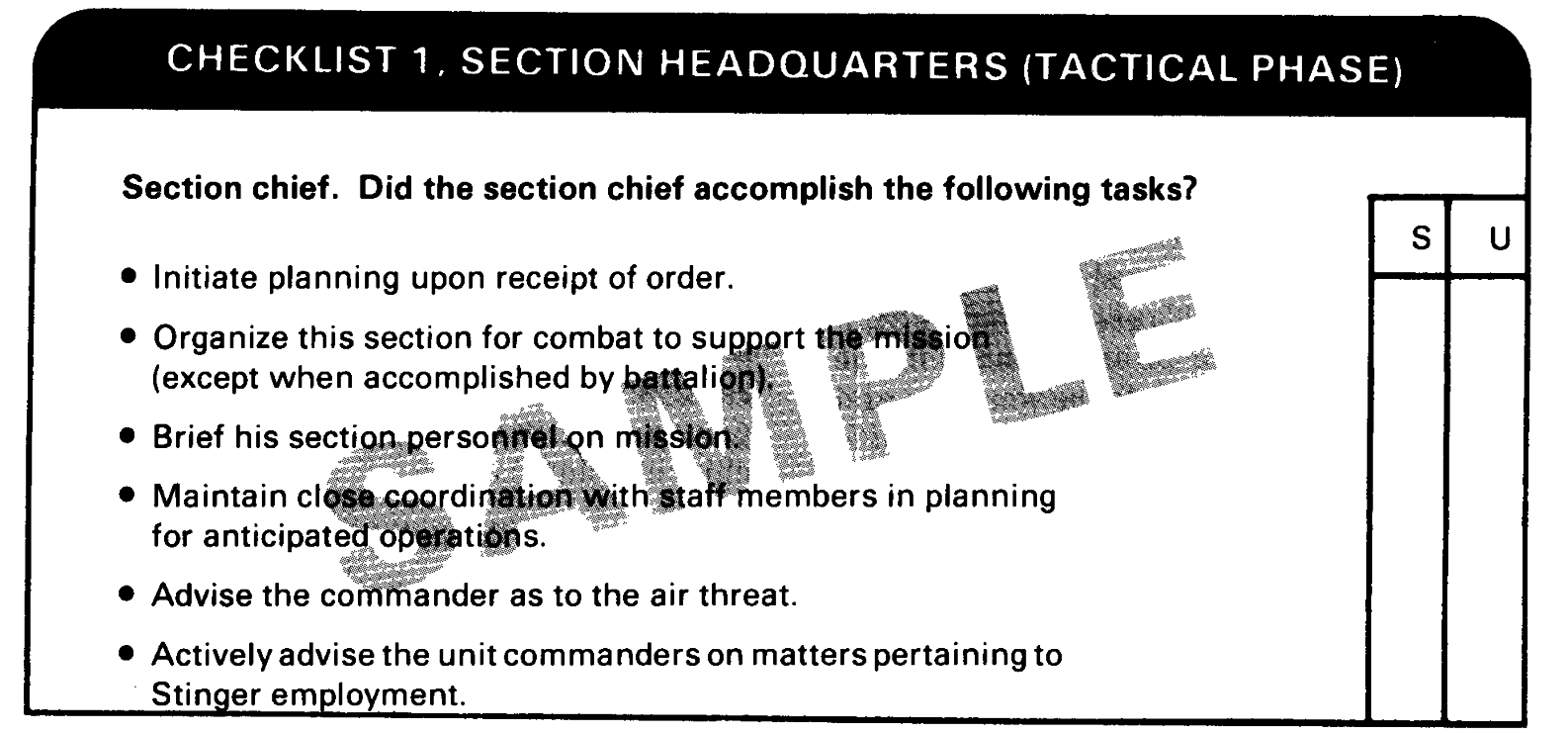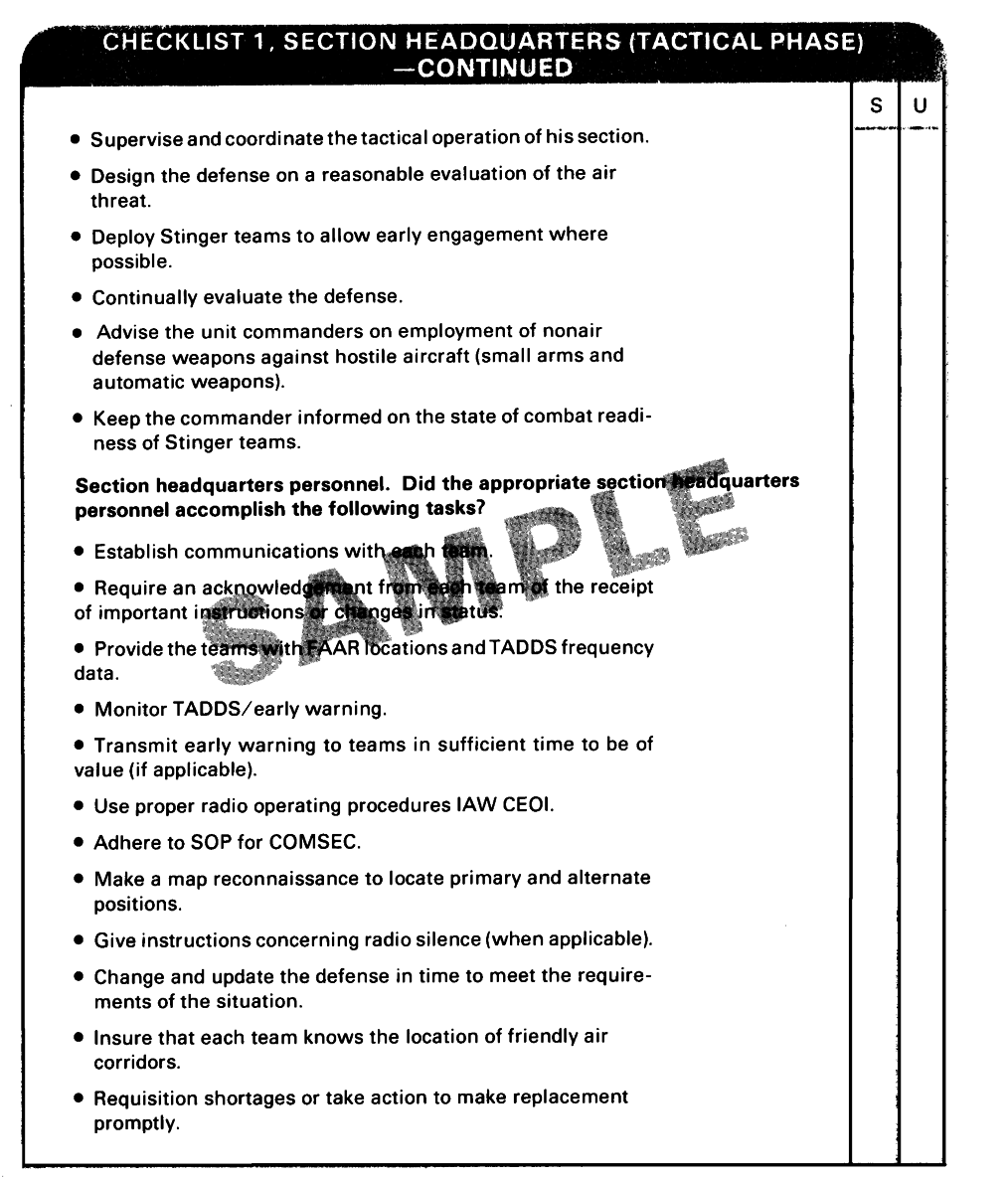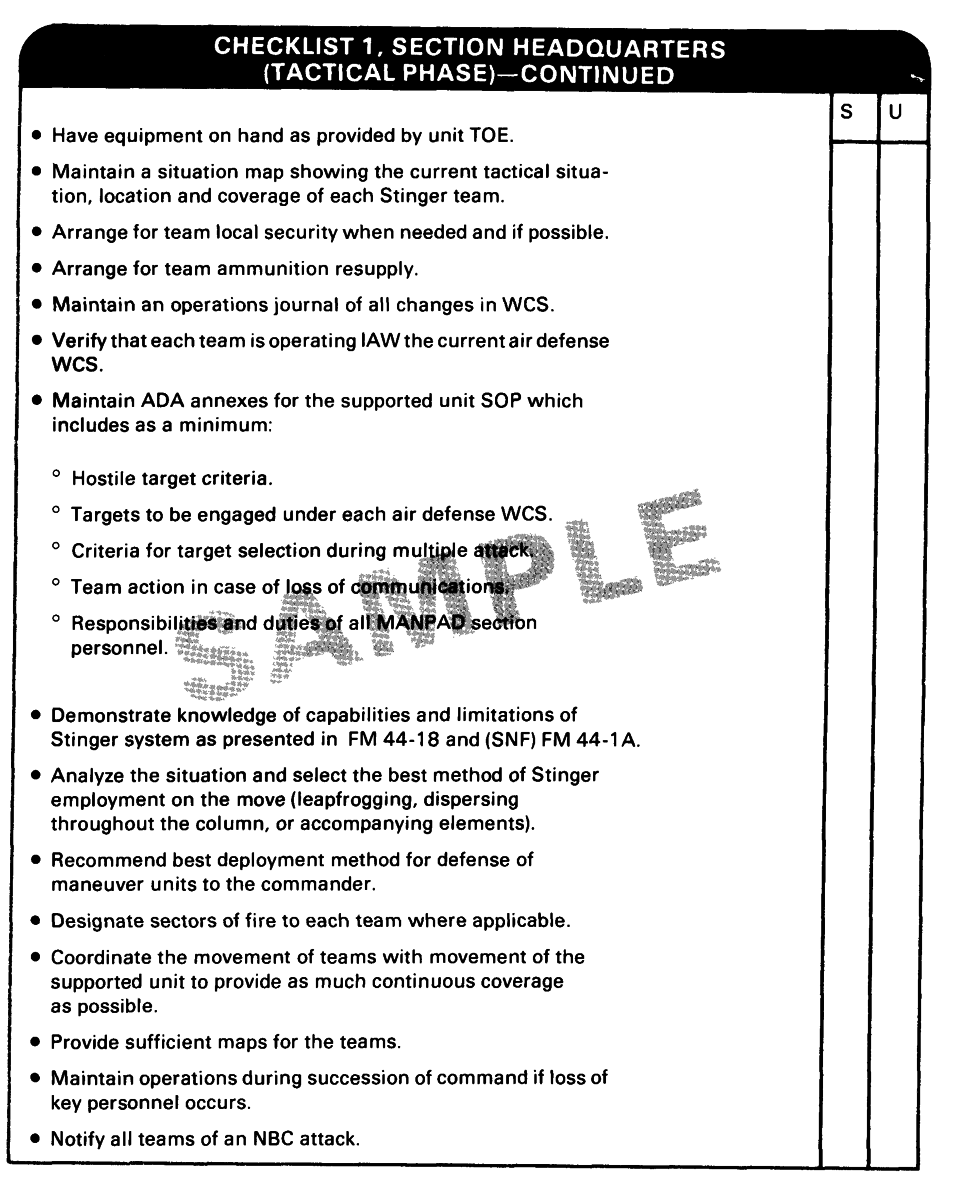be responsible for—
to evaluators to include the following:
❐ Command and control procedures.
■ Insuring that the FTX scenario includes
❐
tactical situations that are applicable to the
Employment and tactics.
❐
testing of the supporting MANPAD section.
Communications nets.
■
❐
Coordinating logistical and administrative
Training set M134 and MTS M87A1.
support for the MANPAD section.
■ Providing combat service support for the
■ Arranging for air attacks during the FTX
tested unit.
and for live aircraft or RCMAT support for
gunner performance (engagement) phase if
The headquarters administering the test
an MTS is not available.
will provide sufficient FAARs to allow Stin-
ger teams to employ the TADDS and receive
■ Arranging for FAAR support.
early warning information.
■ Arranging for the conduct of the firing
Maps of scale 1:50,000/1:25,000 and aerial
phase of the test to include the following:
photos should be used. (Distribution will be
❐ Providing tracking range facilities.
IAW unit SOP.)
❐ Providing an adequate number of training
The chief evaluator conducting the test
sets for Stinger teams to be tested.
of the section may modify the test. He can do
❐ Designing courses to be flown by targets
this to insure that the best use is made of
during simulated firings.
existing facilities, to conform to conditions of
❐ Providing equipment and classroom space
the training situation, or to facilitate attain-
for the testing of aircraft recognition.
ment of training objectives.
■ Providing technical assistance and advice
to evaluators to include the following:
TACTICAL PHASE
The tactical phase of the air defense sec-
all phases of the supported unit’s tactical
tion ORTT can be conducted by modifying
phase with the exception of night operations.
the supported unit’s FTX. This can be done
by including air defense situations that will
TACTICAL MANEUVERS
require the section to defend the supported
unit against low-flying hostile aircraft.
Variations of tactical maneuvers made
by the supported unit including retrograde
COMBAT SUPPORT
operations, delay on successive positions,
and relief, will also involve the deployment of
The Stinger section is a combat support
Stinger to defend the battalion assets. The
element of the battalion. Therefore, employ-
checklists covering each of the tactical opera-
ment and deployment of the section are based
tions can be modified to include requirements
on the tactics employed by the supported
relating to a specific scheme of maneuver. If
maneuver in attack, defense, withdrawal,
the supported unit does not conduct all of
movement to contact, and defense of moving
these type maneuvers, the Stinger section
columns. The section should be tested during
will not be rated for their actions concerning
17-4






FM 44-18-1
any maneuver omitted. A rigid scenario for
The section chief will take control of his
each part of the tactical phase is not included
teams, brief, and deploy them. The chief
because its sequence of timed events could
evaluator will remain with the section head-
conflict with the scenario of the supported
quarters. The remainder of the evaluation
unit.
team will accompany the Stinger teams to
TRAINING DEFICIENCIES
their deployment positions.
As each successive part of the tactical
During the exercise, changes in WCS and
phase is tested, the evaluators record train-
air defense warnings are passed to the sec-
ing deficiencies. The overall proficiency rat-
tion headquarters over the supported unit’s
ing for each part of the tactical phase is
command net. (The evaluation team vehicle
recorded using the tactical phase checklist as
will be equipped with an FM radio.)
a guide. Two checklists are used to evaluate
the section’s tactical phase. Checklist 1 is
ADMINISTRATIVE DETAILS
used to evaluate the section headquarters
FOR TACTICAL PHASE
element. Checklist 2 is used to evaluate the
Stinger teams will be evaluated on their
Stinger team collectively.
speed and reaction to air attack during all
test requirements.
PLANNING AND CONDUCT
The following are important in planning
The headquarters administering the test
and conducting tactical training:
will furnish required information usually
generated by the airspace management ele-
Notification. The exercise notification
ment of the tactical operations center (TOC)
message will be delivered to the Stinger sec-
in the division (or other sources in the case of
tion through command channels. The section
nondivisional units). This information in-
will be directed to report to an assembly area
cludes air alert, changes in WCS, and friendly
within 2 hours (plus travel time) from receipt
flight information. This information may be
of notification.
transmitted to section headquarters by the
Briefing on situation. Upon arrival at the
evaluator in person or by radio.
assembly area, the chief evaluator will brief
An adequate number of FAARs to provide
the section chief. The briefing will include a
early warning data to the deployed Stinger
situation which has a realistic setting for the
teams will be emplaced and operated by
employment of Stinger. The briefing will con-
FAAR platoon personnel. FAAR frequencies
tain the mission and administrative instruc-
and address codes will be obtained from the
tions dictated by local safety regulations and
CEOI.
training area requirements.
Aircraft attacks should be used to evaluate
Conduct. While the section chief conducts
the section’s ability to detect and simulate
a map reconnaissance and designs his
engagement of hostile aerial targets with
defense, the evaluation team inspects vehi-
Stinger. During multiple attacks, each
cles, equipment and loading plans. The eva-
Stinger team will engage the proper target
luation team then tests each team’s ability to
IAW the section SOP. Attacking aircraft will
use authentication tables and operations code
fly at various low altitudes and will conform
in the CEOI. When the section chief indicates
to tactical procedures expected from hostile
he is ready, the chief evaluator critiques the
aircraft. Helicopters should be used in the
defense design.
antitank role, flying nap-of-the-earth, and
17-5








FM 44-18-1
executing attack missions against the force.
aircraft while masked under specific NBC
Liaison with the US Air Force and US Army
conditions for a minimum of one aircraft
aviation operations personnel should be
attack.
made sufficiently in advance of the test IAW
Supplies of all classes not actually pre-
procedures and guidance found in FM 105-5
sented will be simulated. Each team should
and higher headquarters SOP.
start the test with a full basic load of Stinger
The headquarters administering the test
weapons. The team can simulate the basic
will allow the tested section adequate time to
load by having four FHTs in their shipping
prepare positions and establish the defense.
and storage container/ready racks. The addi-
It will then direct the aggressor to initiate
tional FHTs can be obtained from the sec-
low-altitude air reconnaissance or air strikes
tions not participating in the exercise. Also,
against the battalion.
two empty missile-round containers (MRCs)
Emphasis will be placed on signal security
should be available. (The MRC may be simu-
(SIGSEC) procedures, use of CEOI, etc.
lated by using wooden boxes of correct dimen-
sions and weight.)
Stinger teams should be required to engage
FIRING PHASE
The objective of this phase is to test the
range. If gunners are being tested at an MTS,
ability of the Stinger teams to recognize air-
the testing command should select five sim-
craft and engage aerial targets. The firing
ilar courses from appropriate film programs
phase of the test should be conducted separ-
(reels) furnished with the MTS. Each gunner
ately from the tactical phase at a time and
should be tested in the same manner using
place designated by the appropriate com-
the same criteria for consistency. Target
mander. The firing phase should be con-
courses presently include the following
ducted in two parts: a simulated target
variations:
engagement and a test on aircraft recogni-
Crossing left to right, low-altitude, high-
tion. Simulated target engagements may be
performance aircraft.
conducted with actual targets at a suitable
Crossing left to right, low-altitude,
tracking range or with the Stinger MTS.
medium-performance aircraft.
SIMULATED TARGET ENGAGEMENT
Crossing right to left, helicopter.
Each team chief/gunner is required to
Crossing right to left, low-altitude, high-
engage five separate aircraft flying on courses
performance aircraft.
planned by the testing command. The simu-
Directly incoming, low-altitude, high-
lated engagements should be designed to
performance aircraft.
present targets that will test the gunner’s
ability to visually detect targets, make cor-
Evaluators should score the target engage-
rect decisions, and to demonstrate correct
ment part of the firing phase, using checklist
4A. (Checklists are located on pages 17-8
weapon handling procedures. Two engage-
through 17-16.) The scoring procedure and
ments should be conducted under NBC con-
ditions; that is, gunners masked.
evaluation criteria for the gunner are the
same whether the MTS or the tracking range
Target courses described below apply to
is used. This is because the THT is used for
targets used to test gunners at a tracking
the gunner’s evaluation in either case. The
17-6



FM 44-18-1
evaluator must be familiar with the THT and
tions. The test should be conducted using the
understand the procedures for evaluating
same aircraft and criteria listed in the sol-
gunner performance using the readout capa-
dier’s manual and the SQT for Stinger person-
bility of this trainer. A complete operational
nel.
engagement sequence with the trainer dur-
Each gunner should identify the aircraft
ing evaluation of gunner proficiency is des-
shown by writing its name or number
cribed in chapter 15.
designation in the space provided on check-
list 4B. Sufficient time should be allocated
AIRCRAFT RECOGNITION
between slides to allow the tested personnel
During the aircraft recognition part of
to write their response.
the firing phase test, 20 slides will be exposed
Ratings awarded during Parts I and II of
for 5 seconds each. The slides should be
the firing phase should be transferred to
limited to tactical aircraft which are relevant
checklist 5 for use in the final ORTT sum-
to the forward areas of the theater of opera-
mary.
EVALUATOR PERSONNEL
The requirements of the test must be thor-
the other officer and enlisted man act as eval-
oughly explained to all individuals in the sec-
uators for Stinger team performance. During
tion to be tested. Each evaluator must ques-
the firing phase, the evaluators should
tion personnel of the tested unit and must
work together in evaluating gunner skills in
closely observe their performance so that he
engaging targets and in aircraft recognition.
can rate effort and ability fairly and com-
pletely. In no case will members of the section
DUTIES
being tested be detailed as evaluators. Eval-
Each evaluator will perform his assigned
uators will not give instructions or advice to
duties IAW instructions given by the senior
unit personnel other than that necessary for
evaluator. He also will—
the conduct of the test or to insure safety.
Study and understand the checklists, scor-
PERSONNEL
ing system, local conditions affecting the
scoring, and any SOPS in effect during the
The test requires two evaluator officers,
test.
one of whom will serve as senior air defense
section evaluator, and two enlisted men. The
Fairly determine by direct observation,
two officers should be helped by two qualified
ratings for each test activity to be entered on
enlisted evaluators. Officers selected as Stin-
the appropriate checklist.
ger evaluators should be experienced in the
Submit a narrative report to summarize
use of forward area air defense weapons and
ratings indicated on the checklists and take
air defense tactics and also be familiar with
part in the critique when so requested by the
the characteristics, capabilities, and limita-
chief evaluator.
tions of the Stinger weapon. Enlisted evalua-
tors should be qualified Stinger gunners and
CHECKLISTS
also be proficient as vehicle drivers and radio
Checklists found in this chapter may be
operators. One officer, assisted by an enlisted
used in whole or in part, but it is highly
man, should act as evaluator of the section
recommended that local commanders review
headquarters during the tactical phase while
them to insure that they fulfill the training
17-7

FM 44-18-1
objectives in his unit. The commander and
the appropriate spaces in checklist 6.
evaluators must refer to the latest pertinent
field and technical manuals, local directives,
Firing Phase
and the unit SOP for current applicable
Checklist 4A is used to score individual
information as a basis for revising the check-
team members in their ability to engage
lists.
aerial targets with the THT. At least four
engagement ratings of "S" for each action in Tactical Phase
five engagements must be obtained before an
Checklist 1 is used to evaluate the
overall score of "S" can be entered in the MANPAD section headquarters. The evalua-right-hand column. A separate checklist
tor should check the S or U (satisfactory or
should be completed for each Stinger team
unsatisfactory) column in the space provided
chief and gunner. At least 80 percent overall
for each item. After completing the checklist,
scores of "S" must be obtained before the the evaluator should award an overall rating
final grade of "S" can be assigned in check-
to the section headquarters element. This
list 4A.
overall rating should also be recorded in the
appropriate space on checklist 3.
Checklist 4B will be used to score the
Checklist 2 is used to evaluate the Stin-
individual in aircraft recognition skills. These
ger teams during the tactical phase of the
scores will be converted to ratings according
test. A separate checklist should be com-
to the rating scale at the bottom of checklist
pleted for each Stinger team. Team scores are
4B.
entered in the appropriate spaces in checklist
Checklist 5 is used to summarize the fir-
3.
ing phase ratings for the tested unit. Final
Checklist 3 is used to sum up the tactical
ratings for checklists 4A and 4B will be entered
phase ratings for the tested unit. The ratings
on checklist 5.
awarded should approximate the average of
Checklist 6 is used to sum up the tactical
A and B of checklist 2. The tactical phase
and firing phases for the tested unit and
scores from checklist 3 will be transferred to
arrive at an overall score.
17-8

FM 44-18-1
17-9

FM 44-18-1
17-10














FM 44-18-1
17-11













FM 44-18-1
17-12












































































